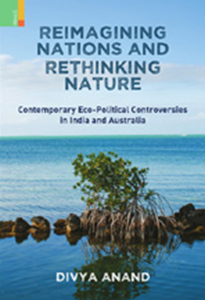
REIMAGINING NATIONS AND RETHINKING NATURE: Contemporary Eco-Political Controversies in India and Australia
AUTHOR- Divya Anand
| HB ₹1195 . $59.95 . ₤47.95 |
||
INFORMATION
- AUTHOR : Divya Anand
- ISBN : 978-93-5290-313-9
- Year : 2019
- Extent : 296 pp.
- Discount available on checkout
- Usually dispatched within 3 to 5 working days.
Rabindranath Tagore
| HB ₹ 1350 . $ . ₤ |
PB ₹ . $ . ₤ |
|
| POD ₹ . $ . ₤ |
e-Book ₹ . $ . ₤ |
INFORMATION
- AUTHOR –
- ISBN – 978-93-84082-82-6
- Year – 2016
- Extent: 400 + 40 coloured illustrations
- 10% discount + free shipping
- Usually dispatched within 3 to 5 working days.
The similarities and differences in the evolution of modern nations across the world are most evident in the ways in which ideas of development and progress engage with the natural environment. India and Australia as nation state emerge from the shared lineage of being part of the British Empire, which has characterized the nature of their respective journeys as modern nation states. Juxtaposing case studies from India and Australia reveals that although both locations differ in their particular historical and social contexts, both contend with similar challenges and compulsions, characteristic of modernity. Employing a multi-scalar and interdisciplinary approach, this work examines issues of nature, nation and development within the context of modernity. While India and Australia have radically different historical imaginations, their paths now increasingly intersect, so that the task of making sense of their very different social imaginaries becomes vital to reimagine the dynamics between nations and nature. In this context, there is much to learn from their respective historic experiences and much that they have in common which demands attention in facing up to the major socioecological challenges of the twenty-first century. This book contributes towards trying to understand the ways in which nations are constantly imagined and find new ways of thinking about nature.
The Author
Divya Anand has worked as a journalist, editor and a diversity and inclusion consultant. She heads an educational consultancy in Boston, USA. Divya has a PhD from La Trobe University, Melbourne and has a number of articles in international publications to her credit.
This volume explores the multifaceted genius of Rabindranath Tagore in rescuing the stagnant cultural life of Bengal from its many inhibitions. He was an ardent supporter of women’s participation in dance and drama. He was a precursor of Indian abstract art. In education, he was heavily influenced by the New School Movement, teaching young children to live in harmony with nature. His works often explore the relationship between human experience, and the landscape and atmosphere and he mobilized the energy of his dedicated children (bratibalakas and bratibalikas) for rural resuscitation. A bitter critic of the aggressive nationalism of the West, he acted as a cultural mascot for the ‘submerged nationalities’ of war-ravaged East Europe. In this collection of essays, our contributors explore the works and legacy of a man much ahead of his time.
The Editor
Chhanda Chatterjee is Professor and Director, Centre for Guru Nanak Dev Studies, and Programme Coordinator, UGC SAP DRS II of the Department of History at Visva-Bharati, Santiniketan, West Bengal. Her publications include Ecology, the Sikh Legacy and the Raj Punjab, 1849-1887 (1997), Ideology, the Rural Power Structure and Imperial Rule: Awadh and Punjab, 1858-1887 (1999), and Literature as History: From Early to Contemporary Times (2014).
Table Of Contents
| Acknowledgements | Ix-X |
| Introduction | |
| India And Australia: Two Paths To And Through Modernity | 1-28 |
| 1. Water For Nation: The Tale Of Two Rivers | 29-75 |
| 2.Remembrance Of Things Past: Unsettling Heritage In Ningaloo And The Sundarbans | 76-124 |
| 3. The Two Faces Of Development: Tasmania And Kerala | 125-173 |
| 4. The Writer As Public Intellectual: Fiction As Environmental Politics | 174-228 |
| Conclusion | 229-236 |
| Bibliography | 237-275 |
| Index | 277-286 |




